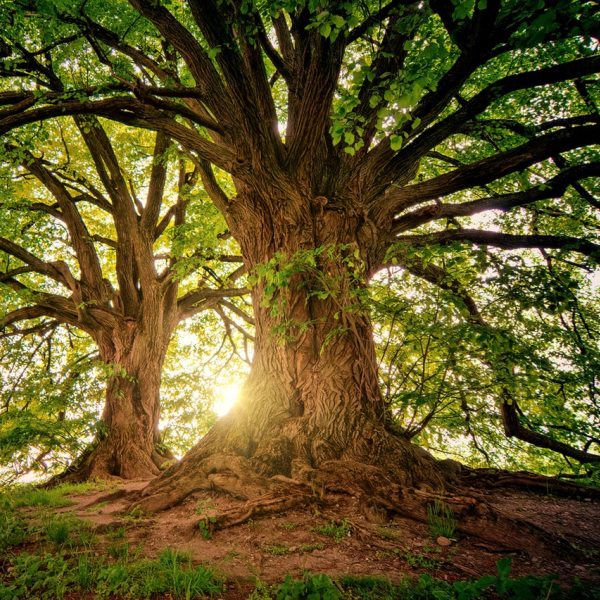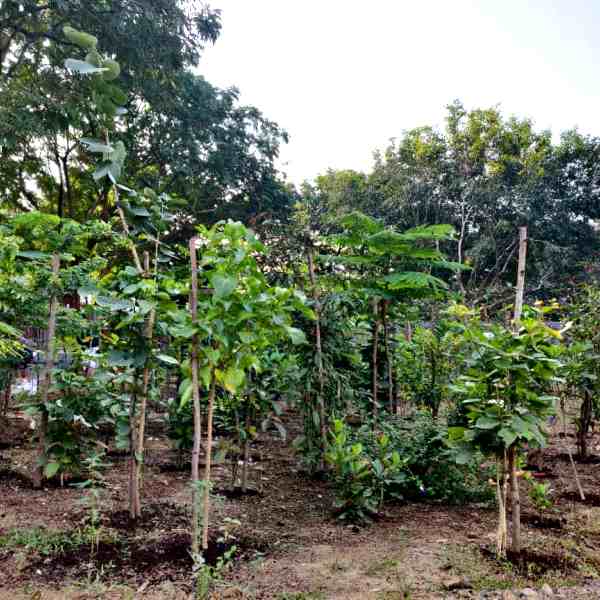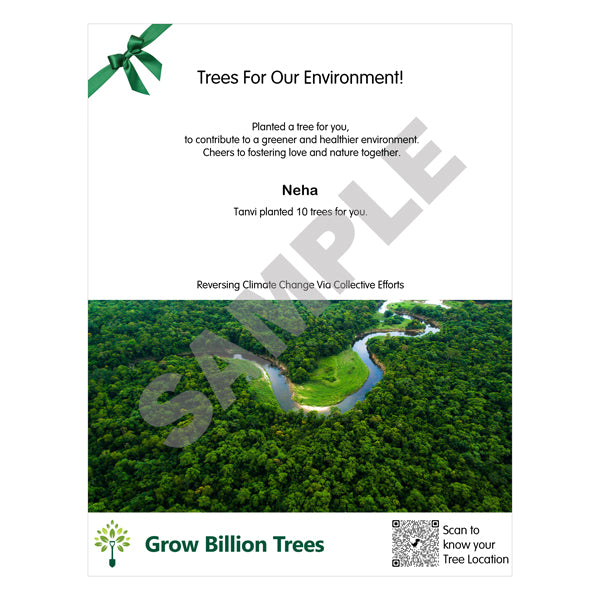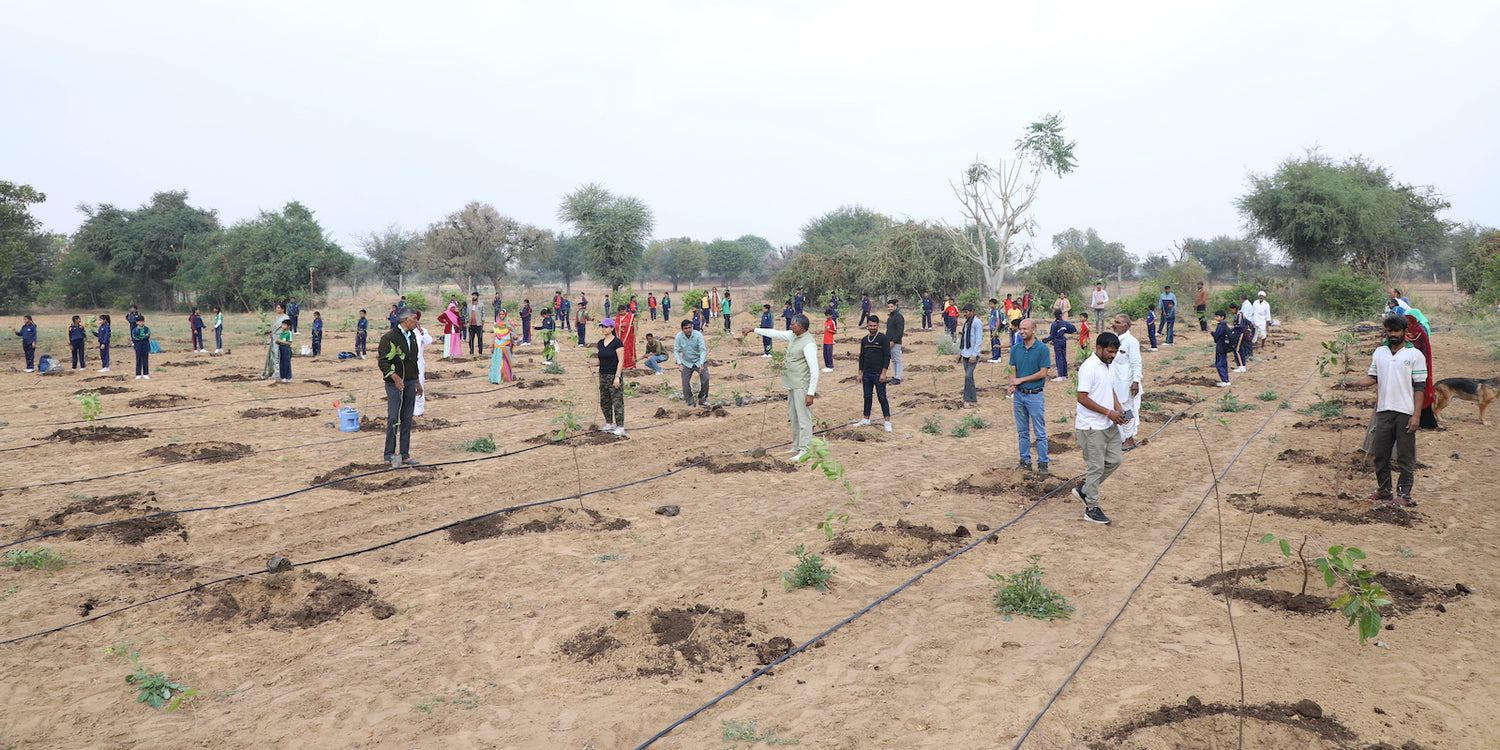Trees for Environment
Trees for Environment
🌳 2-3ft Tree + 3 Years Nurturing + Geo-Tagged
💡 Tip: Plant a tree on behalf of each family member
Plant trees to offset your carbon footprints
Couldn't load pickup availability
What you get ?
Tree(s) Plantation
Tree(s) Plantation
A tree(s) native to the region will be planted within 7 -10 days, and post-plantation monitoring will be thoroughly managed.
*You will receive an email/whatsapp notification immediately after the tree(s) plantation. or you can check the current status by logging into "My Account" anytime.
e-Greeting Card of Tree(s) Plantation for Gifting
e-Greeting Card of Tree(s) Plantation for Gifting
If you want to gift these tree(s) to your loved ones, You can generate an e-Greeting card for tree(s) plantation by logging into "My Account" after placing order.
*Please generate it within 5 days of placing the order.
e-Certificate of Tree(s) Plantation
e-Certificate of Tree(s) Plantation
A e-certificate of Tree(s) Plantation with the project details will be issued in your name after tree(s) plantation.
*You can download it from "My Account".
Geotag of your Tree(s)
Geotag of your Tree(s)
You can immediately track the live location of the project chosen for your tree(s) plantation, by logging into "My Account" or, by scanning the QR code on the certificate.
*You can see Your Name in respective Project/Forest.
If you want to gift these tree(s) to your loved ones, You can generate an e-Greeting card for tree(s) plantation by logging into "My Account" after placing order.
View full details



Planting trees is a crucial strategy for addressing environmental concerns, combating climate change by absorbing carbon dioxide and re Read more
Trending
Plant Trees for the Environment
Description:
Planting trees is a crucial strategy for addressing environmental concerns, combating climate change by absorbing carbon dioxide and releasing oxygen. Trees for the environment play a pivotal role in environmental conservation.
A single mature tree can absorb a remarkable 22 KGs (48 pounds) of CO2 annually, providing a habitat for wildlife and contributing to energy conservation through shade in the summer and windbreaks in the winter.
Scope:
- Enhancement of Biodiversity
- Increase in Green Cover
- Reduction of Man-Animal Conflict
- Generation of Rural Employment
- Improvement of Wildlife Habitats
Tree Species:
The species of trees that are planted depend on the project, and they are chosen based on their native habitat in the corresponding ecological zone.
Why trees?
Beyond World Environment Day, planting trees becomes a celebration of the planet, expressing gratitude for its myriad gifts. Here are compelling reasons to plant trees for the environment:
- Trees, akin to environmental superheroes, absorb carbon dioxide, release oxygen, provide wildlife habitats, and combat soil erosion – all while adding aesthetic appeal.
- Consider this: one mature tree can absorb up to 22 KG (48 pounds) of carbon dioxide annually, marking a substantial environmental impact.
- Trees contribute to energy efficiency, offering shade in summer and acting as windbreaks in winter, thereby lowering heating and cooling costs.
- Tree planting fosters community unity, presenting an opportunity to organize tree-planting events that engage friends, family, and neighbors in a collective and enjoyable activity.
- Lastly, planting trees is a profound gesture of environmental stewardship, reflecting care for the planet and providing a wonderful reason to connect with nature.
Emphasizing these five compelling and engaging reasons encourages tree planting for the environment. Every planted tree contributes to safeguarding the planet, making each effort significant.
Social Impact:
Planting trees can have several social and community benefits, helping reduce carbon emissions and combat climate change. Some of how tree planting can positively impact the community include:
-
Encouraging community involvement: Planting trees as a community activity can bring people together and promote social connections.
-
Fostering a sense of belonging: Participating in a tree-planting event can help to build a sense of ownership and pride in the community.
-
Promoting education and awareness: Tree planting can provide an opportunity for education and learning about the environment, raising awareness about the importance of trees and the role they play in the health and well-being of the planet.
-
Inspiring positive change: By planting trees and sharing the experience with others, you can inspire others to take action and positively impact the environment. This can have a ripple effect, promoting sustainability and positive change in the community and beyond.
Overall, tree planting can be a meaningful and impactful way to contribute to the health and well-being of the community and the environment.
Carbon Sequestration
Trees for Environment actively sequester carbon dioxide, helping to reduce greenhouse gas levels in the atmosphere.
Biodiversity Support
Trees for Environment provide diverse habitats, supporting a wide range of plant and animal species, contributing to overall biodiversity.
Air Quality Improvement
Trees for Environment act as natural air filters, improving air quality by absorbing pollutants and releasing clean oxygen.
Soil Conservation
The roots of Trees for Environment help prevent soil erosion, stabilizing the ground and promoting water retention.
Urban Sustainability
Urban Trees for Environment contribute to sustainable cities by offering shade, reducing heat island effects, and enhancing overall environmental quality.
Economic Benefits
Trees for Environment have economic advantages, providing resources like timber, fruits, and other products, while also boosting property values and attracting tourism.
Water Conservation
Planting Trees for Environment aids in water conservation by reducing runoff, replenishing groundwater, and improving overall water-holding capacity in the soil.
Sound Barriers
Trees for Environment serve as natural sound barriers, absorbing noise and mitigating noise pollution, especially in urban and industrial areas.
Most Popular
Impact of your Tree
-
Releases Oxygen
A mature tree produces around 120 kilograms of oxygen per year, which is sufficient for one human per year.
-
Reduces Air Pollution
A tree absorbs harmful gases like CO2, NO2 released by factories and vehicles, which can have serious health problems for us
-
Removes CO2
A Tree removes 22 KGs of CO2 from atmosphere per year, which is equivalent to the CO2 realeased by a human in 10 days.
-
Cooling Effect
A Tree generates cooling effect of around 10 room size ACs by providing shade and through a process of transpiration.
Special Plantations
FAQ
Why are Trees for Environment crucial?
Why are Trees for Environment crucial
Trees for Environment are vital as they absorb carbon dioxide, release oxygen, and provide habitats for diverse ecosystems, playing a key role in environmental health. How do Trees for Environment contribute to air quality improvement?
Trees for Environment are vital as they absorb carbon dioxide, release oxygen, and provide habitats for diverse ecosystems, playing a key role in environmental health. How do Trees for Environment contribute to air quality improvement
Trees for Environment act as natural air filters, absorbing pollutants and releasing clean oxygen, significantly improving air quality and combating climate change. What role do Trees for Environment play in combating climate change?
Trees for Environment act as natural air filters, absorbing pollutants and releasing clean oxygen, significantly improving air quality and combating climate change. What role do Trees for Environment play in combating climate change
Trees for Environment sequester carbon dioxide, a major greenhouse gas, mitigating climate change effects by reducing overall atmospheric concentrations. How do Trees for Environment prevent soil erosion?
Trees for Environment sequester carbon dioxide, a major greenhouse gas, mitigating climate change effects by reducing overall atmospheric concentrations. How do Trees for Environment prevent soil erosion
The roots of Trees for Environment stabilize the soil, preventing erosion and enhancing water retention, crucial for maintaining healthy and fertile landscapes. What impact do Trees for Environment have on biodiversity?
The roots of Trees for Environment stabilize the soil, preventing erosion and enhancing water retention, crucial for maintaining healthy and fertile landscapes. What impact do Trees for Environment have on biodiversity
Trees for Environment provide habitats for various species, supporting biodiversity by creating ecosystems where different plants, animals, and microorganisms can thrive. Can planting Trees for Environment help conserve water resources?
Trees for Environment provide habitats for various species, supporting biodiversity by creating ecosystems where different plants, animals, and microorganisms can thrive. Can planting Trees for Environment help conserve water resources
Absolutely, Trees for Environment play a role in water conservation by reducing runoff, replenishing groundwater, and enhancing the overall water-holding capacity of the soil. How do urban Trees for Environment contribute to sustainable cities?
Absolutely, Trees for Environment play a role in water conservation by reducing runoff, replenishing groundwater, and enhancing the overall water-holding capacity of the soil. How do urban Trees for Environment contribute to sustainable cities
Urban Trees for Environment offer shade, reduce the urban heat island effect, and improve air quality, making cities more sustainable and livable. Do Trees for Environment have economic benefits for communities?
Urban Trees for Environment offer shade, reduce the urban heat island effect, and improve air quality, making cities more sustainable and livable. Do Trees for Environment have economic benefits for communities
Yes, Trees for Environment contribute to the economy by providing timber, fruits, and other products. Additionally, they enhance property values and attract tourism. Can Trees for Environment act as natural sound barriers?
Yes, Trees for Environment contribute to the economy by providing timber, fruits, and other products. Additionally, they enhance property values and attract tourism. Can Trees for Environment act as natural sound barriers
Trees for Environment absorb sound and reduce noise pollution, making them effective natural barriers in urban and industrial areas. How can individuals contribute to Trees for Environment conservation efforts?
Trees for Environment absorb sound and reduce noise pollution, making them effective natural barriers in urban and industrial areas. How can individuals contribute to Trees for Environment conservation efforts
Individuals can participate in Trees for Environment planting initiatives, support conservation organizations, and practice sustainable living to contribute to the preservation and growth of trees in the environment.?
Individuals can participate in Trees for Environment planting initiatives, support conservation organizations, and practice sustainable living to contribute to the preservation and growth of trees in the environment.





















